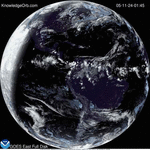Comet PanSTARRS Images Taken from Washington D.C. area 3/14/13

Original Image not enlarged. This gives you an idea if the naked eye view compared to the zoomed in versions. It is small but easily seen with even a small set of binoculars.


Comet Pan-STARRS will emerge from the Sun’s glare low in the western twilight in early and mid-March of 2013. Unfortunately it will probably not be as bright as it was originally predicted.
Seiichi Yoshida, editor of Weekly Information about Bright Comets, has changed his magnitude formula for Comet PanSTARRS. His new predicted light curve has the comet peaking at only magnitude +3 in early March.
The slightly hyperbolic orbit of PanSTARRS shows it’ is a new comet from the outer Oort Cloud. As this happens the comet may brighten significantly as for the first time it’s surface chemicals, currently frozen, vaporize off and form a tail. A new comet from the Oort Cloud is always an unknown quantity equally capable of spectacular displays or dismal failures. This may be the first time it is being warmed by the sun. There is potential for it to put on a good show. “Because of its small distance from the sun, Pan-STARRS should be very active, producing a lot of dust and therefore a nice dust tail,” predicts Matthew Knight of the Lowell Observatory. “However,” he cautions, “it could still be difficult to see. From our point of view on Earth, the comet will be very close to the sun. This means that it is only observable in twilight when the sky is not fully dark.”

On March 10th the comets distance from the Sun will be 0.30 a.u.. This will have a much more significant heating effect on the comet, boiling off the surface chemicals.
See other Astronomical Events this year.


Pan-STARRS VIEWING
In early-mid March look to the west after sunset. You may need Binoculars to pick it out of the sun’s glow (Do NOT look into the Sun!). If you go out to early the sky will be to bright to see it, if you wait to long it will be to low on the horizon. Stay away from trees or buildings. If the skies are clear, and you are away from city light pollution you may be able to see the comet with your bare eyes.
If you take a picture of it contact us and send it we would love to put great pictures on our site!
March 5: Pan-STARRS will be at it’s closest approach to Earth, but not it’s closest approach to the Sun. The tail will not be at it’s brightest. Therefore while it is closest to Earth this is not the peak viewing period.
March 10: The comet will pass closest to the sun. The volatile gases will be at their peak evaporation from the comet. This is what actually forms the tail.
March 12 and 13: The best dates to look for the comet. Pan-STARRS will emerge in the western sunset sky not far from the crescent Moon.
Good luck and happy viewing!!











Hi John,Yes, it is C/2011 L4 PANSTARRS, the only PANSTARRS comet to date to rise to the level of amateur aomnorster and public attention. I thought I had included that as a first reference, but looking back, I see I didn’t. I updated the blog appropriately. Thanks very much for bringing it to my attention.
I went out at 10pm I can`t find it. It has to be earlier?, near sunset. Please advice.
At approx 7:15pm to 7:45pm local time where ever you live. Right after sunset is the only time you can see it. You need to be looking in that window of time after that you will not be able to see it. GOOD LUCK!!!
looking for the bright panstarr!
Wonderfull informative for amatures. Gives rare oportunity for such observation. Thanks.
You have the internet!! you can find it all out.. but ill help. 1. A glaaxy is, by definition, any large collection of stars that can be recognized as a distinct physical entity. In terms of the number of stars, a small dwarf irregular’ glaaxy like the Small Magellanic Cloud, has about one billion stars in it, but there are even smaller systems that are recognized as galaxies such as the Leo I and II dwarf galaxies with about 1 million stars in them, and the Draco System with a few hundred thousand stars in it. The largest star cluster, a globular cluster called Messier 15 has about 6 million stars, so we see that for small galaxies, there is a blurring together of what we mean by a glaaxy and a large star cluster. In addition to their mass and numbers of stars, a glaaxy is a collection of stars and gas which move through the universe independently of the Milky Way. Globular clusters are roundish swarms of stars that orbit the Milky Way, while the Leo and Draco Systems seem to be independent collections of stars. 2. a nebula that was once thought to be a star with its planets but is now thought to be a very hot star surrounded by an expanding envelope of ionized gases that emit a fluorescent glow because of intense radiation from the star 3. cant help with, thats your view.4. Stars are formed as huge clouds of dust and gases, mainly hydrogen and helium. This is combination is called nebula .As the dust and gases swirl around they break into clumps and contract because of gravitational forces. As the clumps bump into each other and get collect more dust and gases they get bigger and their gravity becomes stronger. (The gravity holds the star. ) Since gravity is so strong the particles pack in more tightly. After it is hot enough for nuclear fusion to start you get another star. 5. Hawking radiation.6. work it outThere.Recent college grad with majors in Astronomy and Astrophysics and Physics